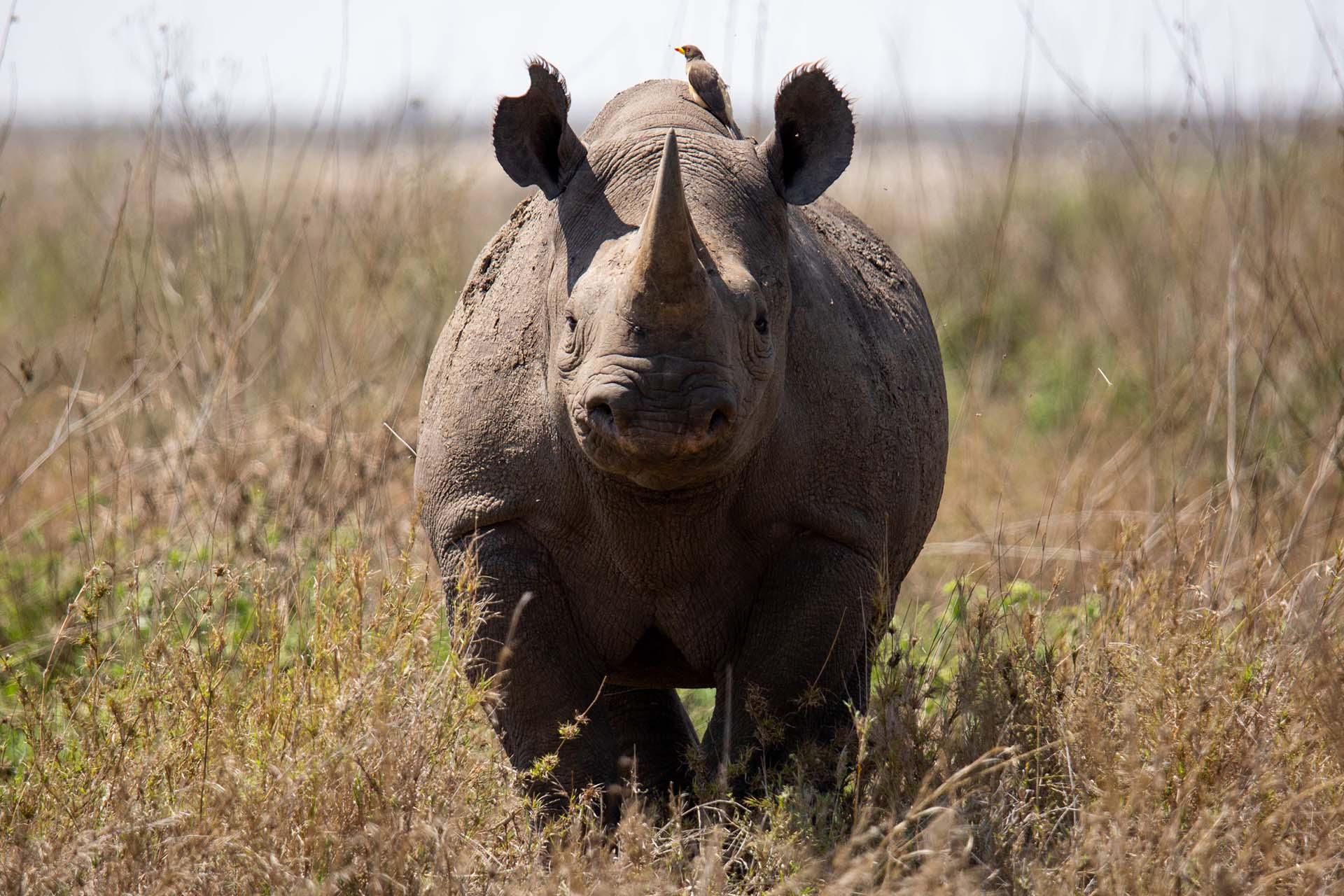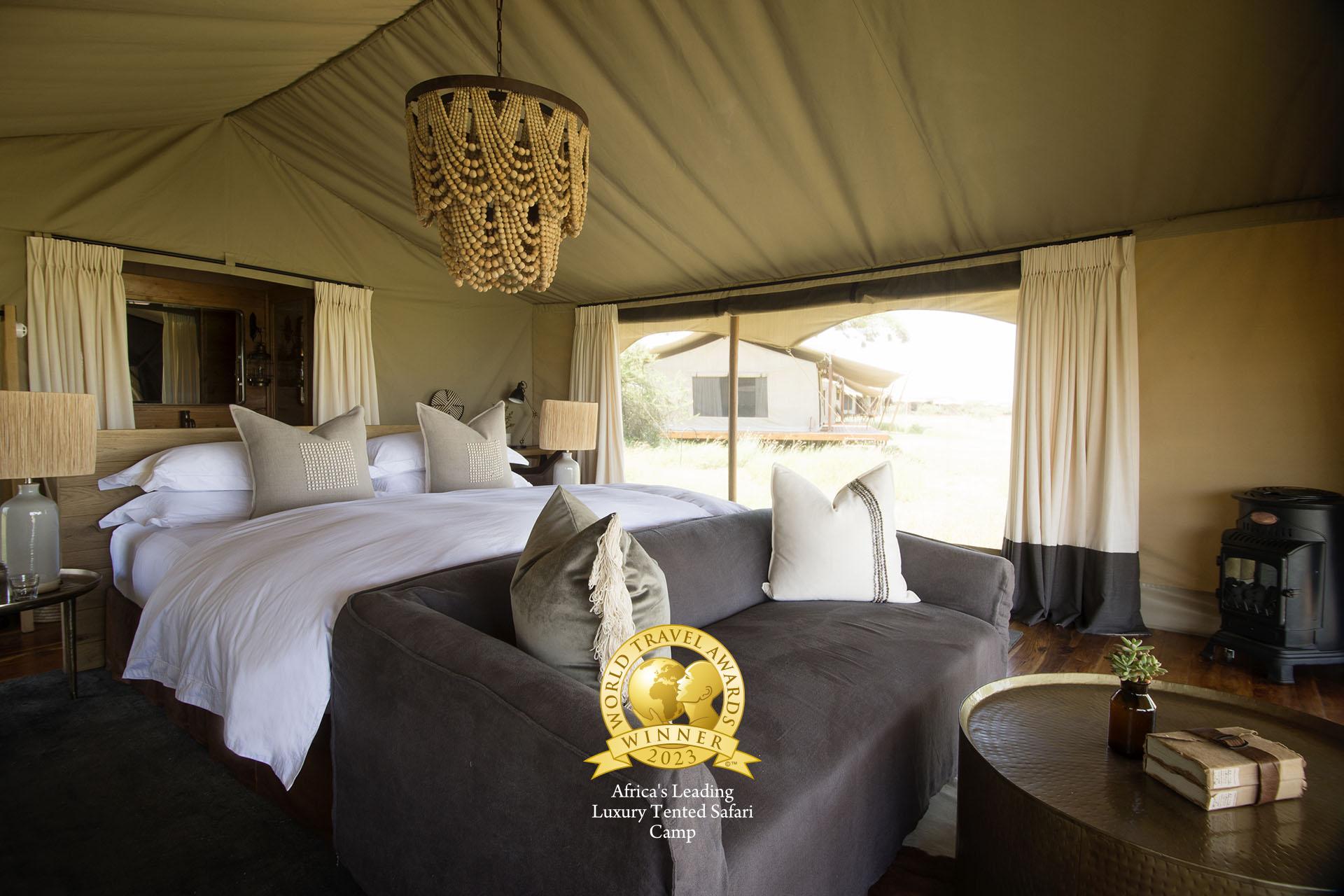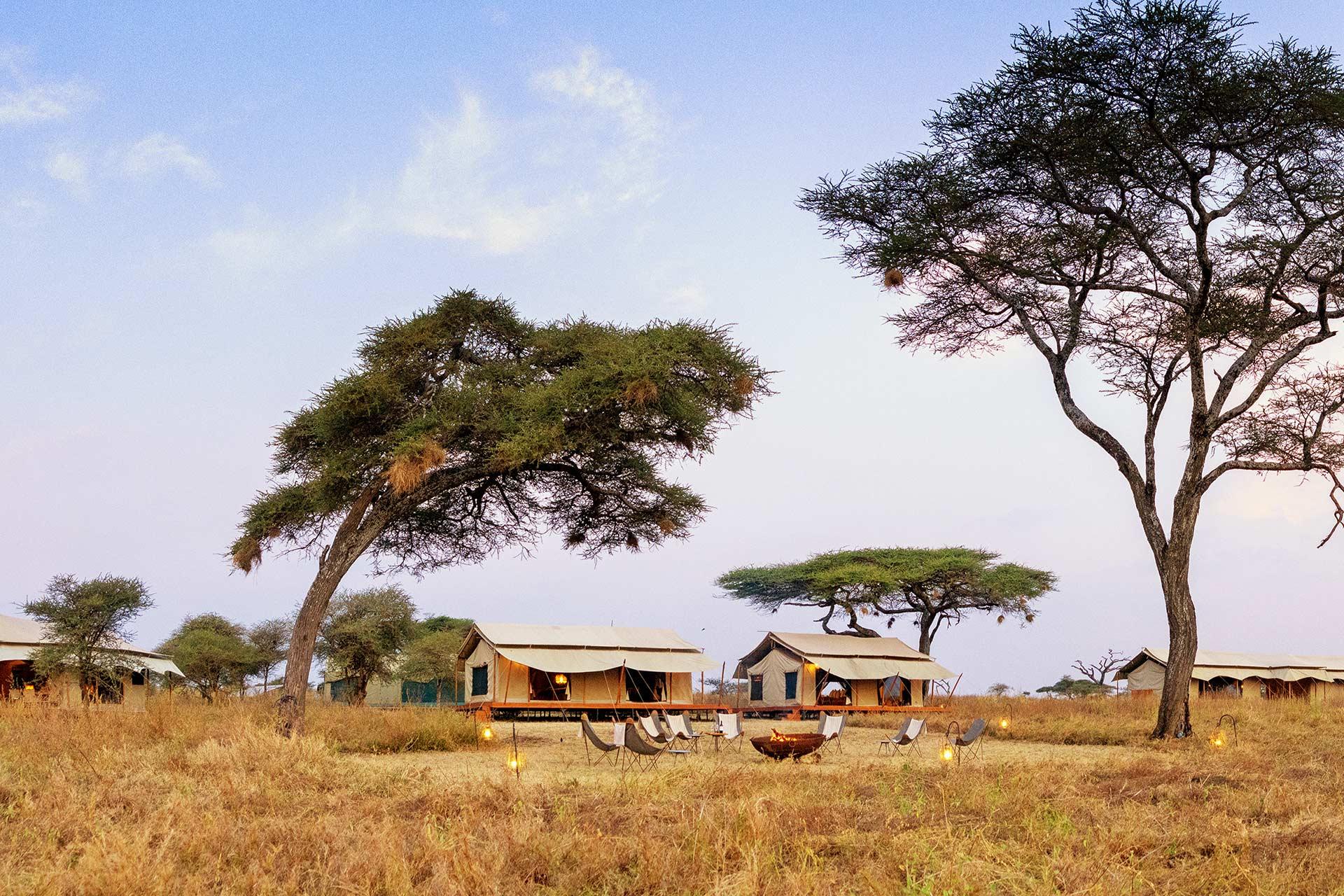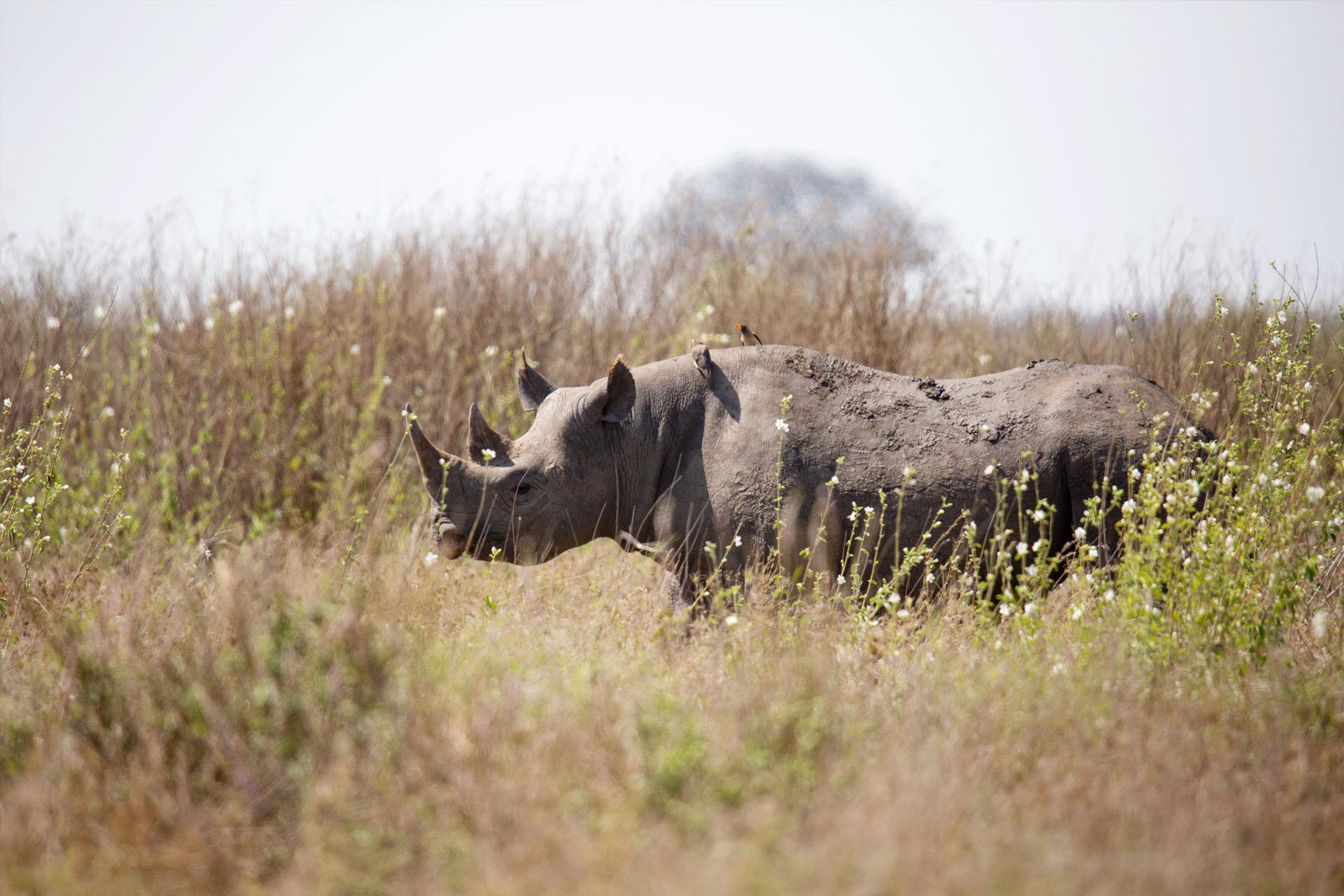Black Rhino
of the Serengeti
As he says this, we see a shadow shape walking in the windswept grass. At first, we assume that this is a buffalo. However, we soon realise that it is the female rhino named Lina. Malale named the rhino after his daughter. He has known her since she was born.
At the sight of the vehicle, she starts running. Malale Mwita anticipates her movements and directs us to slow to follow her downwind. Every time she stops, we stop to allow her to gain confidence in our presence. After about twenty minutes she is comfortable and starts browsing from the shrubs. Now and then she lifts her head and then to my amazement her curiosity leads her towards our vehicle.
I lift my gaze and drop the camera to my lap to enjoy such a pure and raw moment with this magnificent animal. A memory from childhood floods back to me. When I was eight, I made a presentation about endangered species and rhino conservation. There is humankind in humanity. As we drive back to the ranger post, Malale Mwita shares more rhino stories with us, my mind drifts to Rutger Bregman's book "Humankind: A Hopeful History":
"If only we had the courage to take it more seriously, it's an idea that might just start a revolution. Turn society on its head. Because once you grasp what it really means, it's nothing less than a mind-bending drug that ensures you'll never look at the world the same again. So what is this radical idea? That most people, deep down are pretty decent."
It is possible to book your exclusive Rhino safari package when you book accommodation at Siringit Serengeti Camp. Accompanied by a Tanapa ranger you will be able to see a black rhino in its natural habitat and be with that rhino for two hours. Bookings can be madethrough our reservations.
We will be working in collaboration with Tanapa rangers to ensure the protection of the rhinos in Serengeti National Park. The rhinos of Serengeti will continue to live in their natural habitat if we all do our little bit to help restore the wild populations in Tanzania. Tourism is a vital contribution to rhino conservation in the future.
The Rhinos of Serengeti
In August 2020, Tanzania celebrated the birth of the first black rhino in the wild. A celebration of life after years of dedicated training and strategic partnerships to reintroduce the black rhinos into the Serengeti National Park. In the early 1970s, the Frankfurt Zoological society documented a population of 700 wild black rhinos in the Serengeti National Park.
However, this population quickly dwindled to near extinction as the demand and price for rhino horns escalated. Poaching of wildlife for trade as a commodity of medicinal healing threatened the species to extermination. In 1993 a survey on the rhino populations found only three black rhinos living in the Moru Kopjes area of the Serengeti National Park. In 2013 the Convention on International Trade in Endangered Species (CITIES) estimated that there were only one hundred and thirty-three black rhinos left in Tanzania.
In collaboration with the Frankfurt Zoological Society, Tanapa established the first rhino conservation project in Moru Kopjes in southwestern Serengeti. The Michael Grzimek Memorial Rhino Post was built for the national park rangers to be able to monitor, track and protect the black rhinos. In September 2019, Tanzania reintroduced nine rhinos into the Serengeti National Park to boost the populations of wild breeding rhinos in the Serengeti ecosystem and increase genetic diversity.
Article continues below the picture
Moru Kopjes in southwestern Serengeti is a beautiful area, filled with cultural antiquity, diversity of landscape and wildlife. Large sculptural kopjes, overlook the iconic endless plains of the Serengeti National Park. This ecosystem teeming with wildlife is home to some of the last remaining black rhinos. Tanapa ranger Malale Mwita and his team of dedicated rangers, patrol daily protecting the rhinos ensuring that wildlife and its value to tourism is preserved for future generations.
I board a flight from Arusha Airport to Seronera in Central Serengeti. John, assistant manager for Sirinigit Serengeti Camp and Kurwa, our camp driver, are at the airport to meet me. I am in Serengeti to experience and learn the story of the black rhino's reintroduction into Serengeti National Park.
Arriving in Siringit Serengeti Camp is always like returning home. There is a sense of rooted connection to nature which makes it feel like home. The warm greetings from each person on arrival, a smile to lighten any day. The traditional beat of drums is a song for wilderness reviving. Chef Fred greets me from the kitchen with a broad smile of welcome. He is cooking my favourite dish for dinner.
I am escorted to my tent. The interiors are inviting, a sense of peace is instilled in the simplicity of design and its harmony with nature. As I lay my head on the soft pillow, I hear the comforting sounds of the Lions roaring calling me back to the wild.
Article continues below the picture
The following morning, I wake to the Serengeti sunrise alarm, the six o'clock daily bulletin, the birds competing for their chance to announce the African golden sunrise. A splash of warm dappled light floods into the tent. I watch a giraffe elegantly browsing on one of the Acacia trees outside. I hear footsteps and the gentle voice of tent attendant Dominick announcing "Kahawa". The smell of freshly pressed coffee mixed with the aromas of damp dew wilderness beckons me to rise with the sun.
Breakfast is set and displayed, a healthy European start to an African day. Cameras are ready, cards are formatted and placed in our safari vehicle. It takes a short 15-minute drive to arrive at the Seronera Airstrip to buy our Rhino permits from the Tanapa office. We have been told to meet the head ranger Malale Mwita at the Moru Kopjes ranger post at 9 am.
The game drive from Seronera Airstrip to Moru Kopjes is just over an hour. We pass herds of Topi and Gazelle along the way. The dirt road leads us across the endless plains, the horizon stretching to infinity, into an Acacia woodland and the Lion territory. The majestic Moru Kopjes, rise above the plains, whose large patinated boulders perch precariously above the shrubbery of the short grass Serengeti plains.
Malale Mwita is waiting for us at the ranger post. We exchange a traditional greeting, appropriate for an elder, "Skiamoo Mzee". Malale is a tall well-set man, wearing a uniform of green, he stands smiling with radio in hand, his ranger boots laced precisely. We hear the updates received from the unit patrol. They have spotted Lina, one of the female rhinos not far from the ranger posts.
Article continues below the picture
We all clamber in the car and follow Malale's directions veering off the dirt road across the grassy plains. Kurwa is careful to anticipate the hidden aardvark holes concealed beneath the shrubbed grassland. On the way, Malale starts to tell us stories. Delicately woven into his stories are the stories of the black rhinos.
When Malale Mwita was appointed head ranger in Moru Kopjes twenty years ago there were only three black rhinos in the area. Today, he says proudly, there are over fifty black rhinos breeding in the wild. The ranger units are responsible for patrolling an area of 3500 kilometres squared. All the black rhinos in Moru Kopjes have been born in the wild. I ask Malale about the challenges the ranger face in protecting the rhinos in this vast wilderness:
"The biggest challenge we face as rangers is protecting the black rhinos from poachers. Wild predators are also a threat to the rhinos. Lions, Leopards and Hyenas will also attempt to hunt the baby rhinos. Sometimes the mothers will leave their babies when they go to feed and sometimes Hyenas will come and take the young rhino calves.
As rangers, we patrol this whole area inhabited by the black rhinos, and we ensure that the rhinos are protected from poachers. We also record the movements and behaviour of the rhinos so that we know where they are at any given time. We are able the monitor and understand their movements.
Rhinos are territorial animals and the males create a home range of between twenty-thirty kilometres. The females create their territories inside these home ranges. So once we understand the home ranges and territories we can also predict their movement.
During the day around midday, rhinos will find a place to sleep until the afternoon around 4 pm. Then from 4 pm until the morning the rhinos will be walking and eating. Black rhinos are browsers and they eat mostly small shrubs. They are most active during the night and the early and late hours of the day.”
Article continues below the picture
Memories for a lifetime

As he says this, we see a shadow shape walking in the windswept grass. At first, we assume that this is a buffalo. However, we soon realise that it is the female rhino named Lina. Malale named the rhino after his daughter. He has known her since she was born.
At the sight of the vehicle, she starts running. Malale Mwita anticipates her movements and directs us to slow to follow her downwind. Every time she stops, we stop to allow her to gain confidence in our presence. After about twenty minutes she is comfortable and starts browsing from the shrubs. Now and then she lifts her head and then to my amazement her curiosity leads her towards our vehicle.
I lift my gaze and drop the camera to my lap to enjoy such a pure and raw moment with this magnificent animal. A memory from childhood floods back to me. When I was eight, I made a presentation about endangered species and rhino conservation. There is humankind in humanity. As we drive back to the ranger post, Malale Mwita shares more rhino stories with us, my mind drifts to Rutger Bregman's book "Humankind: A Hopeful History":
"If only we had the courage to take it more seriously, it's an idea that might just start a revolution. Turn society on its head. Because once you grasp what it really means, it's nothing less than a mind-bending drug that ensures you'll never look at the world the same again. So what is this radical idea? That most people, deep down are pretty decent."
It is possible to book your exclusive Rhino safari package when you book accommodation at Siringit Serengeti Camp. Accompanied by a Tanapa ranger you will be able to see a black rhino in its natural habitat and be with that rhino for two hours. Bookings can be madethrough our reservations.
We will be working in collaboration with Tanapa rangers to ensure the protection of the rhinos in Serengeti National Park. The rhinos of Serengeti will continue to live in their natural habitat if we all do our little bit to help restore the wild populations in Tanzania. Tourism is a vital contribution to rhino conservation in the future.





